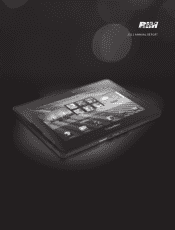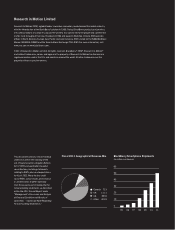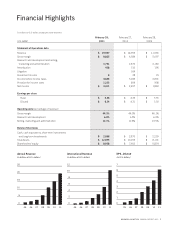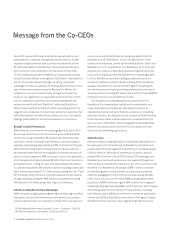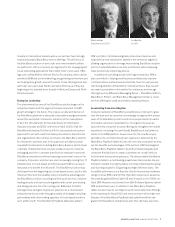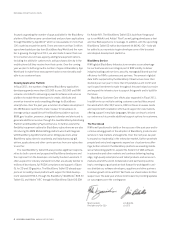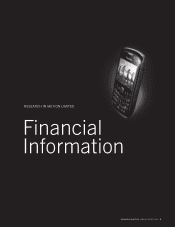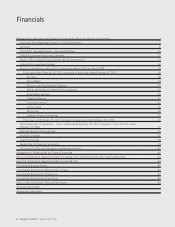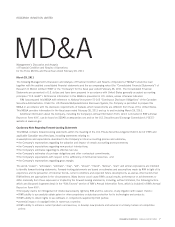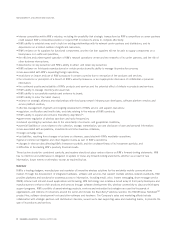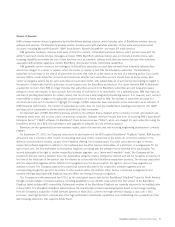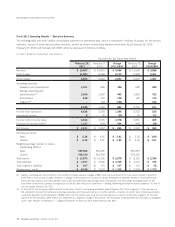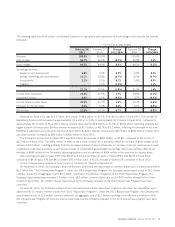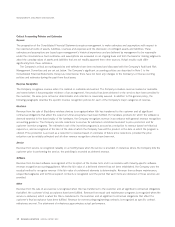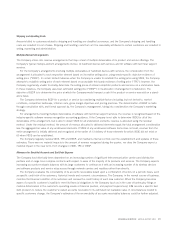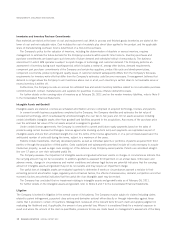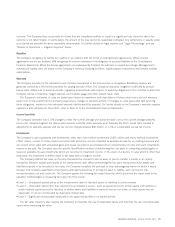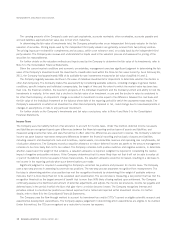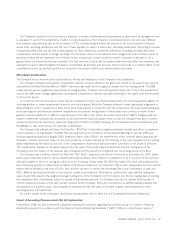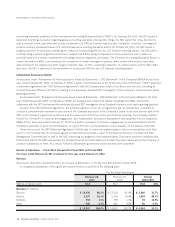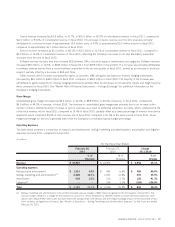Blackberry 2011 Annual Report Download - page 22
Download and view the complete annual report
Please find page 22 of the 2011 Blackberry annual report below. You can navigate through the pages in the report by either clicking on the pages listed below, or by using the keyword search tool below to find specific information within the annual report.Sources of Revenue
RIM’s primary revenue stream is generated by the BlackBerry wireless solution, which includes sales of BlackBerry wireless devices,
software and services. The BlackBerry wireless solution provides users with a wireless extension of their work and personal email
accounts, including Microsoft»Outlook»,IBM»Lotus Notes», Novell»GroupWise», and many ISP email services.
RIM generates hardware revenues from sales, primarily to carriers, of BlackBerry wireless devices, which provide users with the
ability to send and receive wireless messages and data. RIM’s BlackBerry wireless devices also incorporate a mobile phone, web-
browsing capability and enable the use of data functions such as calendar, address book, task and memo lists and other functions
associated with personal organizers. Certain BlackBerry devices also include multimedia capabilities.
RIM generates service revenues from billings to its BlackBerry subscriber account base primarily from a monthly infrastructure
access fee charged to a carrier or reseller, which the carrier or reseller in turn bills the BlackBerry subscriber. The BlackBerry
subscriber account base is the total of all subscriber accounts that have an active status at the end of a reporting period. Each carrier
instructs RIM to create subscriber accounts and determines whether each subscriber account should have an active status. Each
carrier is charged a service fee for each subscriber account each month, with substantially all of such service fees having no regard to
the amount of data traffic that the subscriber account passes over the BlackBerry architecture. If a carrier instructs RIM to deactivate
a subscriber account, then RIM no longer includes that subscriber account in its BlackBerry subscriber account base and ceases
billing the carrier with respect to such account from the date of notification of its deactivation. On a quarterly basis, RIM may make an
estimate of pending deactivations for certain carriers that do not use a fully-integrated provisioning system. It is, however, each carrier’s
responsibility to report changes to its subscriber account status on a timely basis to RIM. The number of subscriber accounts is a
non-financial metric and is intended to highlight the change in RIM’s subscriber base and should not be relied upon as an indicator of
RIM’s financial performance. The number of subscriber accounts does not have any standardized meaning prescribed by U.S. GAAP
and may not be comparable to similar metrics presented by other companies.
An important part of RIM’s BlackBerry wireless solution is the software that is installed at the corporate or small- and medium-size
enterprise server level, and in some cases, on personal computers. Software revenues include fees from: (i) licensing RIM’s BlackBerry»
Enterprise Server
TM
(“BES”) software; (ii) BlackBerry»Client Access Licenses (“CALs”), which are charged for each subscriber using the
BlackBerry service via a BES; (iii) maintenance and upgrades to software; and (iv) technical support.
Revenues are also generated from non-warranty repairs, sales of accessories and non-recurring engineering development contracts
(“NRE”).
On September 27, 2010, the Company announced its development of the WiFi enabled BlackBerry»PlayBook
TM
tablet. RIM has also
announced that it intends to offer models incorporating wide area mobile connectivity in the future. As is common practice in the
wireless communications industry, as part of the PlayBook offering, the Company plans to provide users with the right to receive
unspecified software upgrades in addition to the hardware and therefore has two deliverables, at a minimum, in arrangements for the
sale of each unit. The first deliverable is the physical PlayBook unit along with the software that is essential to its functionality. The
second deliverable is the right to receive unspecified software upgrades, on a “when-and-if-available” basis. The Company will be
required to allocate revenue between these two deliverables using the relative selling price method and will not recognize all revenue at
the time of the initial sale of the product into the channel as it does with the BlackBerry smartphone products. The revenue associated
with the unspecified upgrades will be deferred and recognized over the period in which the rights to receive these upgrades are
available to users. The Company expects the proportional amount allocated to the unspecified software upgrades and the
corresponding recognition period to be similar to other vendors within the industry. Other factors, contractual arrangements and
bundled offerings associated with PlayBook may also affect the timing of revenue recognition.
The Company recently announced April 2011 as the anticipated launch date for the BlackBerry»PlayBook
TM
tablet in North America
through a broad network of channel partners, including availability in over 20,000 retail outlets. The first version of the BlackBerry
PlayBook tablet includes WiFi connectivity. Subsequent versions of the BlackBerry PlayBook are currently expected to be available later
in fiscal 2012. The BlackBerry PlayBook tablet features the new BlackBerry Tablet Operating System based on technology resulting
from the Company’s acquisition of QNX Software Systems in fiscal 2011, a seven inch high definition display, a dual core 1 GHZ
processor, dual high definition cameras and other high performance multimedia capabilities, true multitasking and a powerful and fast
web browsing experience that supports Adobe Flash.
RESEARCH IN MOTION ANNUAL REPORT 2011 9


